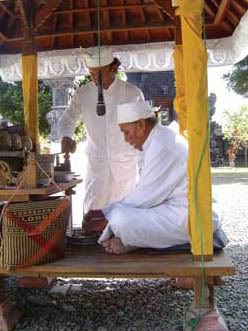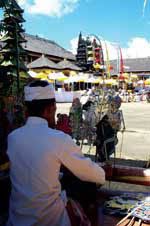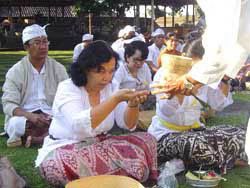 Purnama or full moon is an auspicious day to Balinese people. Many important Hindu rituals fall upon or are held at this time. The day is believed to bring happiness both socially and spiritually. The significance of purnama, however has changed over recent times.
Purnama or full moon is an auspicious day to Balinese people. Many important Hindu rituals fall upon or are held at this time. The day is believed to bring happiness both socially and spiritually. The significance of purnama, however has changed over recent times.
In the past, say four or five decades ago, purnama had more meaning for romantic things, while its ritual dimension was rather insignificant. Between the1950s and 1970s, purnama was the day that teenagers were always very much looking forward to. On the purnama day, they enjoyed the brightness of the night by going to the beach. Teenagers in Denpasar, for example, went to Sanur beach to enjoy the beauty of the full moon. Many people also swam at the beach that night. They believed that by swimming at the beach on purnama day, they were not just cleaning their bodies but also their minds.
Because the transport facilities before the 1970s was not as modern as nowadays, Denpasar inhabitants went to Sanur by bicycle. Limited street lighting on the road was not an obstacle to their travelling by bicycle because the moon poured its shining light on the road. One after another bicycle usually went to Sanur on the night of purnama. The light of the moon not only eased the ride but also accentuated the romance of their journey.
On the purnama night, Sanur beach was packed with people, usually until midnight, when most of the visitors went home. People avoided hanging around at the beach until late at night because of the magical images of the area. Besides going to Sanur at purnama, teenagers also liked to go to the cinema. New releases of films were often shown for the first time at purnama so as to be able to attract a bigger audience. Sanur beach and the cinema were among the few places available for recreation at that time.
Going to Sanur for teenagers also let them see the 'splendour' of the first and only ten storeyed building in Bali; The Grand Bali Beach Hotel located on Sanur beach. This hotel was the most attractive object for local people to see during holidays such as Galungan and Kuningan or New Year.
Nowadays, purnama in Sanur is still beautiful, but people do not need to wait to come to the beach on that day. People can come to Sanur every day if they like. Purnama and Sanur no longer have a strong connection. The tall building on Sanur beach, which used to be considered so splendid, has now lost its attractiveness. Also, the number of places for recreation has increased; now it is mainly malls and cafes where teenagers like to hang around at the week end.
The romantic dimension of the full moon has become less celebrated by teenagers nowadays. Changes have taken place, marked by more spiritual activities, held on purnama day. On the night of purnama, young people around the town of Denpasar prefer to put on their Balinese attire and go to pray at the temple Jagatnatha, located in the front of Puputan Badung Park. The praying itself does not take long. Some people like to stay up late in the temple or doing what they called makemit, praying and establishing peace of mind but others like to hang around the temple and the Puputan Badung Park until late night. During the purnama night, the park is packed with people, a scene that did not exist three decades or so ago. Those who come to Jagatnatha temple are mostly young people, including school students. On purnama day, students of high schools in Denpasar go to school after hours to pray at their school temple. Some stay there until late at night, while others go to Jagatnatha temple to pray again.
The spiritual dimension of purnama has been very strong recently. Every purnama, many primary and secondary school students in Denpasar, and in other regions throughout Bali, come to school without uniform but wearing traditional Balinese attire. They pray at school together before the classes start. Non-Balinese kids may wear Balinese attire if they wish, although they do not have to.











